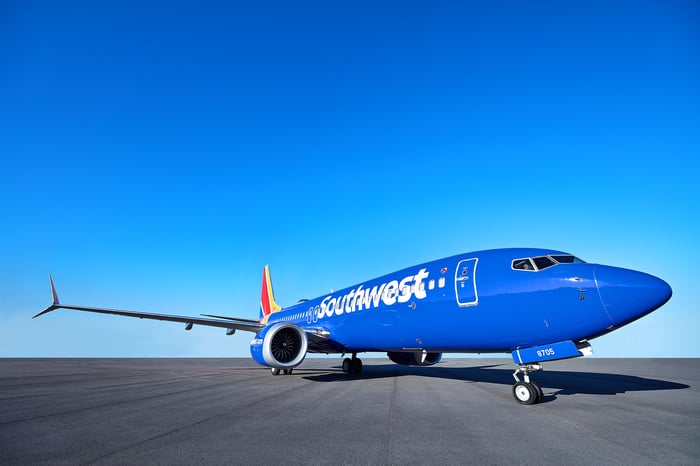In recent weeks, domestic-focused airlines JetBlue Airways (JBLU 0.52%) and Alaska Air (ALK -1.16%) have raised their unit revenue forecasts for the second quarter, boosted by a favorable supply demand balance.
Last week, Southwest Airlines (LUV -1.00%) followed suit, telling investors that revenue per available seat mile (RASM) will come in near the upper end of its initial guidance range this quarter. However, this strong unit revenue growth is being driven by the Boeing (BA -0.49%) 737 MAX grounding, which has constrained Southwest's capacity. As a result, the carrier is facing a huge jump in unit costs that will put pressure on its profitability.
A mixed outlook for the second quarter
Two months ago, Southwest Airlines projected that RASM would increase 5.5% to 7.5% in the second quarter. That was by far the strongest unit revenue forecast offered by any of the major airlines.
Last Wednesday, Southwest said that it now expects RASM to rise 6.5% to 7.5%. The increase to its guidance range wasn't very surprising, given that JetBlue and Alaska Air are also on track to outperform the midpoints of their initial forecasts. Additionally, Southwest further reduced its capacity outlook in the recent investor update, saying that capacity is likely to fall about 3.5% year over year this quarter, compared to its previous forecast of a 2% to 3% decline. The airline attributed the change to a higher-than-expected number of flight cancellations.

The 737 MAX grounding has forced Southwest to reduce its capacity. Image source: Southwest Airlines.
While lower capacity tends to boost unit revenue, it also drives up unit costs. Back in April, Southwest Airlines predicted a shockingly large 10.5% to 12.5% jump in adjusted nonfuel unit costs in the second quarter. Due to its lower-than-planned capacity this quarter, the airline now expects adjusted nonfuel unit costs to increase 11.5% to 12.5%.
To add insult to injury, Southwest's fuel efficiency will deteriorate this quarter, because its most fuel-efficient planes are currently grounded. The net result is that higher costs will almost fully offset Southwest Airlines' RASM growth, keeping the company's profitability roughly flat year over year in Q2.
The Boeing 737 MAX grounding will drag on
Unfortunately, while the 737 MAX is supposedly close to being recertified, progress toward getting the troubled jet back in service has been painfully slow. It could be weeks -- or longer -- before a final order recertifying the type for service comes through. After that, it could take a month or more to perform required maintenance, install any necessary upgrades, and retrain pilots.
That's why Southwest Airlines recently extended its 737 MAX flight cancellations from Aug. 5 through Sept. 2. With the latest schedule change, Southwest will be missing its Boeing 737 MAX fleet for the entirety of the peak summer travel season.
As a result, investors should expect the third quarter to look similar to the second quarter for Southwest. Due to capacity constraints, the carrier is likely to post strong unit revenue growth, offset by a big uptick in adjusted nonfuel unit costs.
A big opportunity for rivals
As the Boeing 737 MAX grounding wears on, Southwest's capacity is diverging further and further from its plans. The carrier has 34 grounded 737 MAX 8s, and prior to the grounding, it was scheduled to expand its 737 MAX fleet to 75 jets by year-end -- nearly 10% of its entire fleet.
For Southwest Airlines, the 737 MAX grounding is hurting earnings modestly, as the increase in unit costs from having so many planes out of service tends to outweigh the RASM benefit of cutting capacity. However, Southwest's woes spell opportunity for the carrier's rivals.
It probably isn't a coincidence that JetBlue Airways and Alaska Airlines have both raised their RASM outlooks this quarter. While neither carrier has a ton of route overlap with Southwest, they both benefit from the limited availability of cheap Southwest Airlines one-stop fares. This means they should have ample pricing power during the summer peak season, leading to strong unit revenue growth. Meanwhile, both carriers are insulated from the cost impacts of the 737 MAX grounding and have favorable cost outlooks for the third quarter and beyond.
Of course, Southwest Airlines will eventually get its 737 MAX fleet back in the air, perhaps as early as September. When that happens, rivals like JetBlue and Alaska will again face a tougher pricing environment. But until then, they should be able to earn bumper profits.





